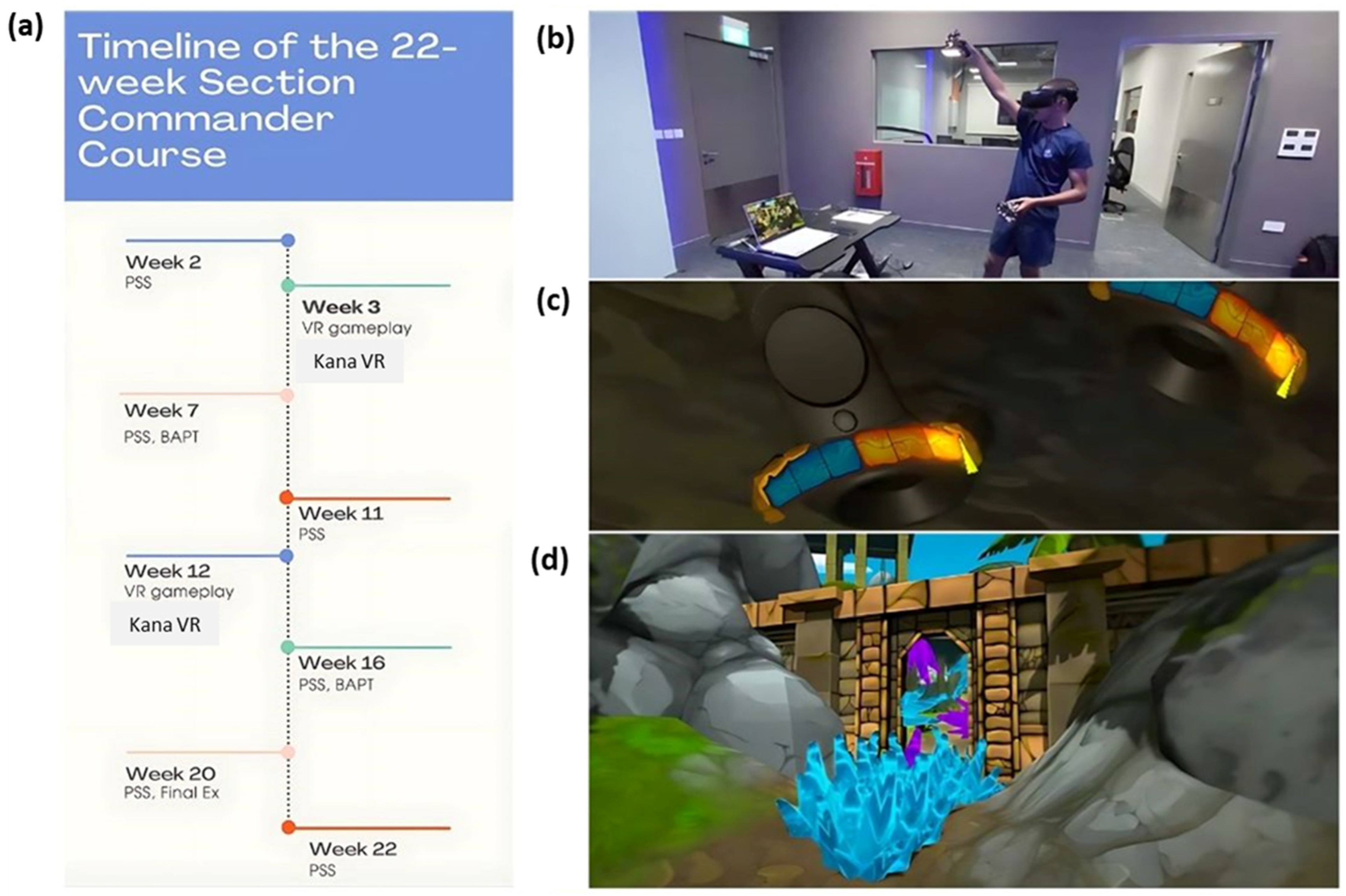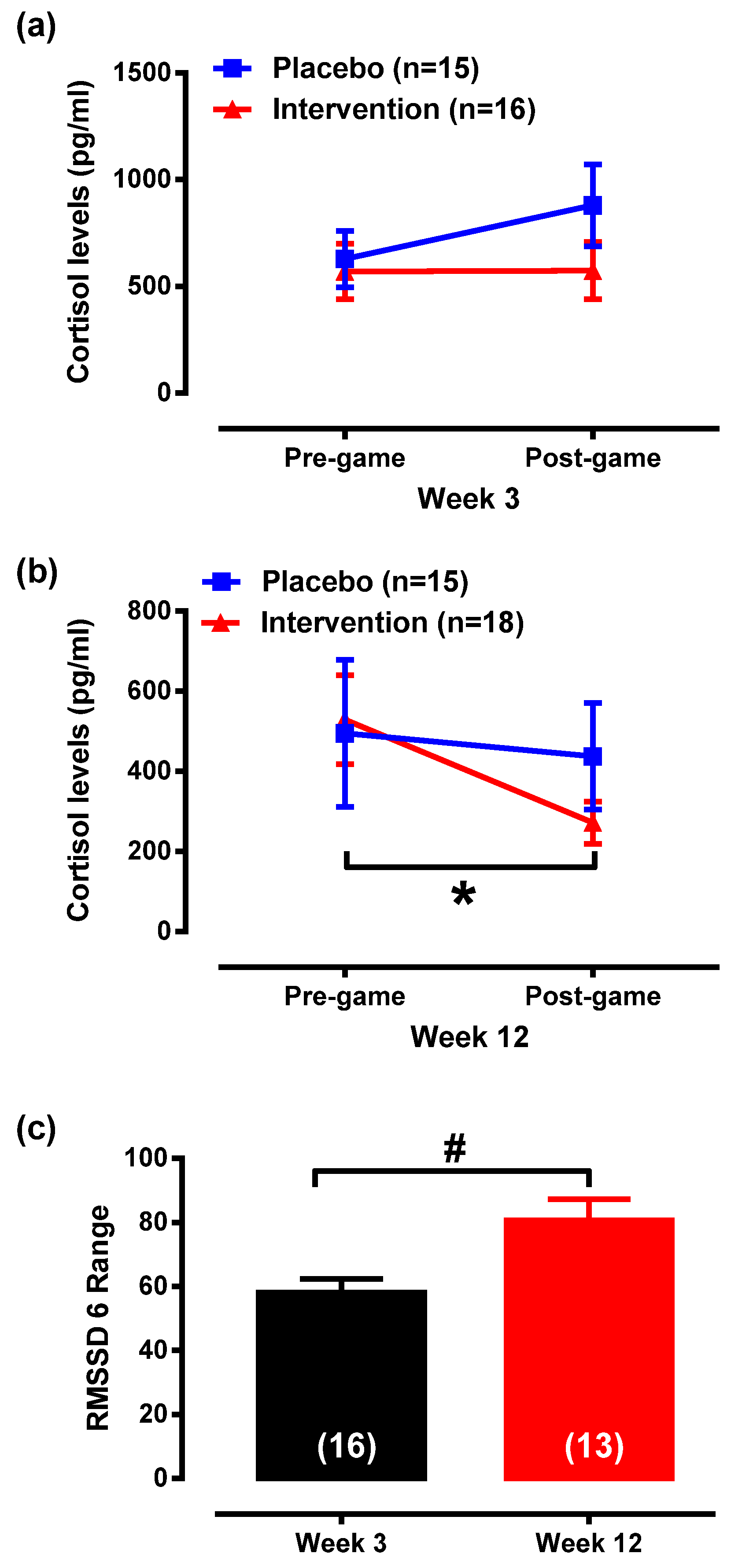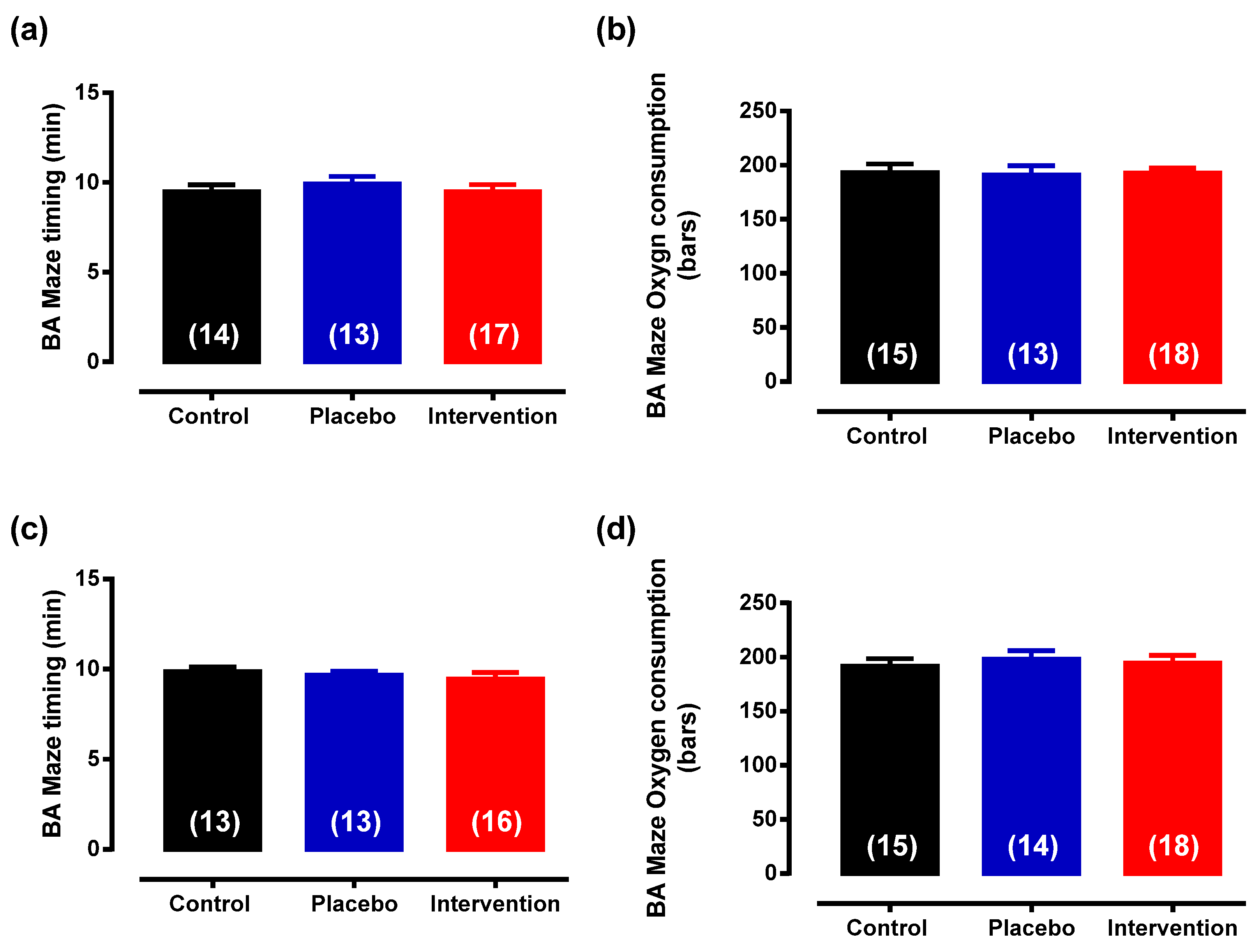A Virtual Reality Game-Based Intervention to Enhance Stress Mindset and Performance among Firefighting Trainees from the Singapore Civil Defence Force (SCDF)
Abstract
:1. Introduction
2. Material and Methods
2.1. IRB Approval
2.2. Experimental Design
2.3. Psychological Response Measurements
2.3.1. Perceived Stress Scale (PSS)
2.3.2. Stress Mindset Measure (SMM)
2.4. Physiological Response Measurements
2.4.1. Heart Rate Variability (HRV)
2.4.2. Saliva Collection and Cortisol Levels
2.5. Training Performance Measurements
2.5.1. Breathing Apparatus Proficiency Test (BAPT)
2.5.2. Final Exercise Assessment (Final EX)
2.5.3. Statistical Analysis
3. Results
3.1. Psychological Stress Response Measurements
3.2. Physiological Stress Response Measurements
3.3. Training Performance Measurements
4. Discussion
5. Conclusions
Author Contributions
Funding
Institutional Review Board Statement
Informed Consent Statement
Data Availability Statement
Acknowledgments
Conflicts of Interest
References
- Amanvermez, Y.; Zhao, R.; Cuijpers, P.; de Wit, L.M.; Ebert, D.D.; Kessler, R.C.; Bruffaerts, R.; Karyotaki, E. Effects of self-guided stress management interventions in college students: A systematic review and meta-analysis. Internet Interv. 2022, 28, 100503. [Google Scholar] [CrossRef] [PubMed]
- Antony, J.; Brar, R.; Khan, P.A.; Ghassemi, M.; Nincic, V.; Sharpe, J.P.; Straus, S.E.; Tricco, A.C. Interventions for the prevention and management of occupational stress injury in first responders: A rapid overview of reviews. Syst. Rev. 2020, 9, 121. [Google Scholar] [CrossRef] [PubMed]
- Christopher, M.; Bowen, S.; Witkiewitz, K. Mindfulness-based resilience training for aggression, stress and health in law enforcement officers: Study protocol for a multisite, randomized, single-blind clinical feasibility trial. Trials 2020, 21, 236. [Google Scholar] [CrossRef] [PubMed]
- Everly, G.S., Jr.; Flannery, R.B., Jr.; Eyler, V.A. Critical Incident Stress Management (CISM): A statistical review of the literature. Psychiatr. Q. 2002, 73, 171–182. [Google Scholar] [CrossRef]
- Maglione, M.A.; Chen, C.; Bialas, A.; Motala, A.; Chang, J.; Akinniranye, G.; Hempel, S. Stress Control for Military, Law Enforcement, and First Responders: A Systematic Review. Rand Health Q. 2022, 9, 20. [Google Scholar] [PubMed]
- Arnetz, B.B.; Arble, E.; Backman, L.; Lynch, A.; Lublin, A. Assessment of a prevention program for work-related stress among urban police officers. Int. Arch. Occup. Environ. Health 2013, 86, 79–88. [Google Scholar] [CrossRef] [PubMed]
- McCraty, R.; Atkinson, M.; Lipsenthal, L.; Arguelles, L. New hope for correctional officers: An innovative program for reducing stress and health risks. Appl. Psychophysiol. Biofeedback 2009, 34, 251–272. [Google Scholar] [CrossRef] [PubMed]
- Backman, L.A.B.; Levi, D.; Lunlin, A. Psychophysiological effects of mental imaging training for police trainees. Stress Med. 1997, 13, 43–48. [Google Scholar] [CrossRef]
- Andersen, J.P.; Papazoglou, K.; Koskelainen, M.; Nyman, M.; Gustafsberg, H.; Arnetz, B.B. Applying Resilience Promotion Training Among Special Forces Police Officers. Sage Open 2015, 5, 2158244015590446. [Google Scholar] [CrossRef]
- Ramey, S.L.; Perkhounkova, Y.; Hein, M.; Chung, S.; Franke, W.D.; Anderson, A.A. Building Resilience in an Urban Police Department. J. Occup. Environ. Med. 2016, 58, 796–804. [Google Scholar] [CrossRef]
- Bezerra Cde, M.; Minayo, M.C.; Constantino, P. Occupational stress among female police officers. Cienc. Saude Coletiva 2013, 18, 657–666. [Google Scholar]
- Bergman, A.L.; Christopher, M.S.; Bowen, S. Changes in facets of mindfulness predicts stress and anger outcomes for police officers. Mindfulness 2016, 7, 851. [Google Scholar] [CrossRef]
- Christopher, M.S.; Goerling, R.J.; Rogers, B.S.; Hunsinger, M.; Baron, G.; Bergman, A.L.; Zava, D.T. A pilot study evaluating the effectiveness of a mindfulness-based intervention on cortisol awakening response and health outcomes among law enforcement officers. J. Police Crim. Psychol. 2016, 31, 15–28. [Google Scholar] [CrossRef]
- Igboanugo, S.; Bigelow, P.L.; Mielke, J.G. Health outcomes of psychosocial stress within firefighters: A systematic review of the research landscape. J. Occup. Health 2021, 63, e12219. [Google Scholar] [CrossRef] [PubMed]
- Patterson, G.T.; Chung, I.W.; Swan, P.W. Stress management interventions for police officers and recruits: A meta-analysis. J. Exp. Criminol. 2014, 10, 487–513. [Google Scholar] [CrossRef]
- Ma, X.; Yue, Z.Q.; Gong, Z.Q.; Zhang, H.; Duan, N.Y.; Shi, Y.T.; Wei, G.X.; Li, Y.F. The Effect of Diaphragmatic Breathing on Attention, Negative Affect and Stress in Healthy Adults. Front. Psychol. 2017, 8, 874. [Google Scholar] [CrossRef] [PubMed]
- Watson, D.; Clark, L.A.; Tellegen, A. Development and validation of brief measures of positive and negative affect: The PANAS scales. J. Pers. Soc. Psychol. 1988, 54, 1063–1070. [Google Scholar] [CrossRef] [PubMed]
- Berking, M.; Meier, C.; Wupperman, P. Enhancing emotion-regulation skills in police officers: Results of a pilot controlled study. Behav. Ther. 2010, 41, 329–339. [Google Scholar] [CrossRef]
- Hall, S. Fire Loss in the United States. Available online: https://www.nfpa.org/education-and-research/research/nfpa-research/fire-statistical-reports/fire-loss-in-the-united-states (accessed on 8 March 2024).
- Keech, J.J.; Cole, K.L.; Hagger, M.S.; Hamilton, K. The association between stress mindset and physical and psychological wellbeing: Testing a stress beliefs model in police officers. Psychol. Health 2020, 35, 1306–1325. [Google Scholar] [CrossRef]
- Stofella, A.; Fadel, L.M. Fidelity and Play Model: Balancing Seriousness; IGI Global: Hershey, PA, USA, 2019. [Google Scholar] [CrossRef]
- Torres, A.; Kapralos, B.; Da Silva, C.; Peisachovich, E.; Dubrowski, A. Moirai: A No-Code Virtual Serious Game Authoring Platform. Virtual Worlds 2022, 1, 147–171. [Google Scholar] [CrossRef]
- Stansfield, S.; Shawver, D.; Sobel, A. MediSim: A prototype VR system for training medical first responders. In Proceedings of the IEEE 1998 Virtual Reality Annual International Symposium, Atlanta, GA, USA, 14–18 March 1998; pp. 198–205. [Google Scholar]
- Jerčić, P.; Sundstedt, V. Practicing emotion-regulation through biofeedback on the decision-making performance in the context of serious games: A systematic review. Entertain. Comput. 2020, 29, 75–86. [Google Scholar] [CrossRef]
- Maarsingh, B.M.; Bos, J.; Van Tuijn, C.F.J.; Renard, S.B. Changing Stress Mindset Through Stressjam: A Virtual Reality Game Using Biofeedback. Games Health J. 2019, 8, 326–331. [Google Scholar] [CrossRef] [PubMed]
- Houzangbe, S.C.O.; Gorisse, G.; Richir, S. Fear as a biofeedback game mechanic in virtual reality: Effects on engagement and perceived usability. In Proceedings of the 13th International Conference on the Foundations of Digital Games, Malmö, Sweden, 7–10 August 2018; pp. 1–6. [Google Scholar]
- Crum, A.J.; Salovey, P.; Achor, S. Rethinking stress: The role of mindsets in determining the stress response. J. Pers. Soc. Psychol. 2013, 104, 716–733. [Google Scholar] [CrossRef] [PubMed]
- Crum, A.J.; Akinola, M.; Martin, A.; Fath, S. The role of stress mindset in shaping cognitive, emotional, and physiological responses to challenging and threatening stress. Anxiety Stress Coping 2017, 30, 379–395. [Google Scholar] [CrossRef] [PubMed]
- Hamilton, L.D.; Meston, C.M. The role of salivary cortisol and DHEA-S in response to sexual, humorous, and anxiety-inducing stimuli. Horm. Behav. 2011, 59, 765–771. [Google Scholar] [CrossRef]
- Mouthaan, J.; Sijbrandij, M.; Luitse, J.S.; Goslings, J.C.; Gersons, B.P.; Olff, M. The role of acute cortisol and DHEAS in predicting acute and chronic PTSD symptoms. Psychoneuroendocrinology 2014, 45, 179–786. [Google Scholar] [CrossRef] [PubMed]
- Cohen, S.; Kamarck, T.; Mermelstein, R. Measuring Stress: A Guide for Health and Social Scientists; Oxford University Press: Oxford, UK, 1995. [Google Scholar]
- Tegegne, B.S.; Man, T.; van Roon, A.M.; Snieder, H.; Riese, H. Reference values of heart rate variability from 10-second resting electrocardiograms: The Lifelines Cohort Study. Eur. J. Prev. Cardiol. 2020, 27, 2191–2194. [Google Scholar] [CrossRef]
- Zimmer, P.; Buttlar, B.; Halbeisen, G.; Walther, E.; Domes, G. Virtually stressed? A refined virtual reality adaptation of the Trier Social Stress Test (TSST) induces robust endocrine responses. Psychoneuroendocrinology 2019, 101, 186–192. [Google Scholar] [CrossRef] [PubMed]
- Shanmugham, M.; Devasia, A.G.; Chin, Y.L.; Cheong, K.H.; Ong, E.S.; Bellanger, S.; Ramasamy, A.; Leo, C.H. Time-dependent specific molecular signatures of inflammation and remodelling are associated with trimethylamine-N-oxide (TMAO)-induced endothelial cell dysfunction. Sci. Rep. 2023, 13, 20303. [Google Scholar] [CrossRef]
- Leo, C.H.; Ng, H.H.; Marshall, S.A.; Jelinic, M.; Rupasinghe, T.; Qin, C.; Roessner, U.; Ritchie, R.H.; Tare, M.; Parry, L.J. Relaxin reduces endothelium-derived vasoconstriction in hypertension: Revealing new therapeutic insights. Br. J. Pharmacol. 2020, 177, 217–233. [Google Scholar] [CrossRef]
- Tan, S.S.Y.; Shanmugham, M.; Chin, Y.L.; An, J.; Chua, C.K.; Ong, E.S.; Leo, C.H. Pressurized Hot Water Extraction of Mangosteen Pericarp and Its Associated Molecular Signatures in Endothelial Cells. Antioxidants 2023, 12, 1932. [Google Scholar] [CrossRef]
- Brelet, L.G.Y. Stress reduction interventions: A scoping review to explore progress toward use of haptic feedback in virtual reality. Front. Virtual Real. 2022, 3, 900970. [Google Scholar] [CrossRef]
- Hamari, J.; Shernoff, D.J.; Rowe, E.; Coller, B.; Asbell-Clarke, J.; Edwards, T. Challenging games help students learn: An empirical study on engagement, flow and immersion in game-based learning. Comput. Hum. Behav. 2016, 54, 170–179. [Google Scholar] [CrossRef]
- Pallavicini, F.A.D.; Repetto, C.; Gorini, A.; Riva, G. Biofeedback, virtual reality and mobile phones in the treatment of generalized anxiety disorder (GAD): A phase-2 controlled clinical trial. J. Cyber. Ther. Rehabil. 2009, 2, 315–327. [Google Scholar]
- Przybylski, A.K.; Rigby, C.S.; Ryan, R.M. A motivational model of video game engagement. Rev. Gen. Psychol. 2010, 14, 154–166. [Google Scholar] [CrossRef]
- Xu, J.K.A.; Juni, S.; Ku, J.; Sami, H.; Lin, V.; Walterson, R.; Payne, E.; Jo, H.; Rahimpoor-Marnani, P. A systematic review evaluating the effectiveness of virtual reality-based well-being interventions for stress reduction in young adults. medRxiv 2023, 11, e52186. [Google Scholar] [CrossRef]
- Epel, E.S.; McEwen, B.S.; Ickovics, J.R. Embodying psychological thriving: Physical thriving in response to stress. J. Soc. Issues 2018, 74, 703–722. [Google Scholar] [CrossRef]
- Lopes Dos Santos, M.; Uftring, M.; Stahl, C.A.; Lockie, R.G.; Alvar, B.; Mann, J.B.; Dawes, J.J. Stress in Academic and Athletic Performance in Collegiate Athletes: A Narrative Review of Sources and Monitoring Strategies. Front. Sports Act Living 2020, 2, 42. [Google Scholar] [CrossRef] [PubMed]
- Muñoz, A.R.; Vega-Díaz, M.; González-García, H. Team Cohesion Profiles: Influence on the Development of Mental Skills and Stress Management. J. Sports Sci. Med. 2023, 22, 637–644. [Google Scholar] [CrossRef]
- Erschens, R.; Adam, S.H.; Schröpel, C.; Diebig, M.; Rieger, M.A.; Gündel, H.; Zipfel, S.; Junne, F. Improving Well-Being and Fostering Health-Oriented Leadership among Leaders in Small and Medium-Sized Enterprises (SMEs): A Systematic Review. Healthcare 2024, 12, 486. [Google Scholar] [CrossRef]
- Lehmann, J.A.M.; Schwarz, E.; Rahmani Azad, Z.; Gritzka, S.; Seifried-Dübon, T.; Diebig, M.; Gast, M.; Kilian, R.; Nater, U.; Jarczok, M.; et al. Effectiveness and cost effectiveness of a stress management training for leaders of small and medium sized enterprises-study protocol for a randomized controlled-trial. BMC Public Health 2021, 21, 468. [Google Scholar] [CrossRef] [PubMed]
- Valladares Ríos, L.; Acosta-Diaz, R.; Santana-Mancilla, P.C. Enhancing Self-Learning in Higher Education with Virtual and Augmented Reality Role Games: Students’ Perceptions. Virtual Worlds 2023, 2, 343–358. [Google Scholar] [CrossRef]
- Lee, Y.S.; Rashidi, A.; Talei, A.; Beh, H.J.; Rashidi, S. A Comparison Study on the Learning Effectiveness of Construction Training Scenarios in a Virtual Reality Environment. Virtual Worlds 2023, 2, 36–52. [Google Scholar] [CrossRef]
- Chu, C.E.; Cheong, G.S.W.; Mishra, A.; Wen, Y.; Leo, C.H.; Yeo, D.J.; Cheong, K.H. Enhancing Biology Laboratory Learning: Student Perceptions of Performing Heart Dissection with Virtual Reality; IEEE Access: New York, NY, USA, 2024; pp. 76682–76691. [Google Scholar]
- Salim, R.B.S.M.; Chen, J.S.; Leo, C.H.; Rai, B. Design and development of MemoryTrail virtual reality game to study brain and memory processes in a fun and interactive manner. J. Appl. Learn. Teach. 2023, 6, 1. [Google Scholar]





| Group | VR Game-Based Training | Psychological Response Measurements | Physiological Response Measurements | Training Performance Measurements |
|---|---|---|---|---|
| Control | No | PSS | NIL | BAPT, Final EX |
| Placebo | Yes (without biofeedback) | PSS | Cortisol levels | BAPT, Final EX |
| Intervention | Yes (with biofeedback) | PSS, SMM | HRV, Cortisol levels | BAPT, Final EX |
| 10-Item Questions | Likert Scale (0 = Never, 4 = Very Often) |
|---|---|
| In the last month, how often have you been upset because of something that happened unexpectedly? | |
| In the last month, how often have you felt that you were unable to control the important things in your life? | |
| In the last month, how often have you felt nervous and “stressed”? | |
| In the last month, how often have you felt confident about your ability to handle your personal problems? | |
| In the last month, how often have you felt that things were going your way? | |
| In the last month, how often have you found that you could not cope with all the things that you had to do? | |
| In the last month, how often have you been able to control irritations in your life? | |
| In the last month, how often have you felt that you were on top of things? | |
| In the last month, how often have you been angered because of things that were outside of your control? | |
| In the last month, how often have you felt difficulties were piling up so high that you could not overcome them? |
| 8-Item Questions | Likert Scale (0 = Strongly Disagree, 4 = Strongly Agree) |
|---|---|
| The effects of stress are negative and should be avoided | |
| Experiencing stress facilitates my learning and growth | |
| Experiencing stress depletes my health and vitality | |
| Experiencing stress enhances my performance and productivity | |
| Experiencing stress inhibits my learning and growth | |
| Experiencing stress improves my health and vitality | |
| Experiencing stress debilitates my performance and productivity | |
| The effects of stress are positive and should be utilized |
Disclaimer/Publisher’s Note: The statements, opinions and data contained in all publications are solely those of the individual author(s) and contributor(s) and not of MDPI and/or the editor(s). MDPI and/or the editor(s) disclaim responsibility for any injury to people or property resulting from any ideas, methods, instructions or products referred to in the content. |
© 2024 by the authors. Licensee MDPI, Basel, Switzerland. This article is an open access article distributed under the terms and conditions of the Creative Commons Attribution (CC BY) license (https://creativecommons.org/licenses/by/4.0/).
Share and Cite
Imran, M.A.D.B.; Goh, C.S.Y.; V, N.; Shanmugham, M.; Kuddoos, H.; Leo, C.H.; Rai, B. A Virtual Reality Game-Based Intervention to Enhance Stress Mindset and Performance among Firefighting Trainees from the Singapore Civil Defence Force (SCDF). Virtual Worlds 2024, 3, 256-269. https://doi.org/10.3390/virtualworlds3030013
Imran MADB, Goh CSY, V N, Shanmugham M, Kuddoos H, Leo CH, Rai B. A Virtual Reality Game-Based Intervention to Enhance Stress Mindset and Performance among Firefighting Trainees from the Singapore Civil Defence Force (SCDF). Virtual Worlds. 2024; 3(3):256-269. https://doi.org/10.3390/virtualworlds3030013
Chicago/Turabian StyleImran, Muhammad Akid Durrani Bin, Cherie Shu Yun Goh, Nisha V, Meyammai Shanmugham, Hasan Kuddoos, Chen Huei Leo, and Bina Rai. 2024. "A Virtual Reality Game-Based Intervention to Enhance Stress Mindset and Performance among Firefighting Trainees from the Singapore Civil Defence Force (SCDF)" Virtual Worlds 3, no. 3: 256-269. https://doi.org/10.3390/virtualworlds3030013
APA StyleImran, M. A. D. B., Goh, C. S. Y., V, N., Shanmugham, M., Kuddoos, H., Leo, C. H., & Rai, B. (2024). A Virtual Reality Game-Based Intervention to Enhance Stress Mindset and Performance among Firefighting Trainees from the Singapore Civil Defence Force (SCDF). Virtual Worlds, 3(3), 256-269. https://doi.org/10.3390/virtualworlds3030013






